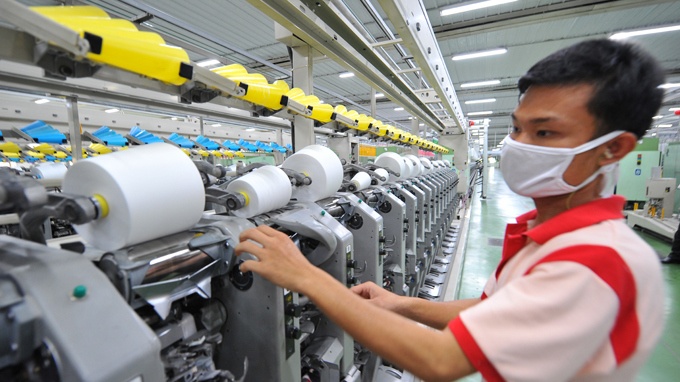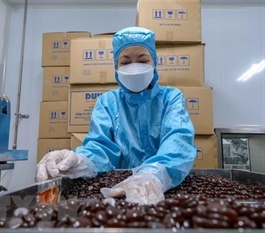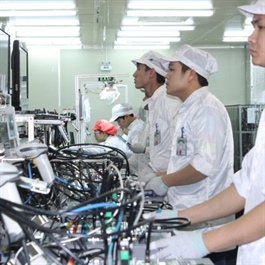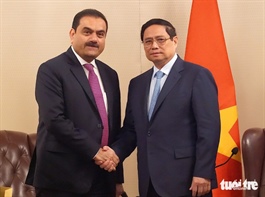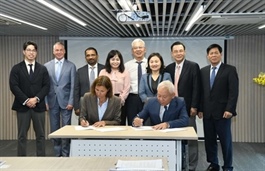Great opportunities for semiconductor industry in Hà Nội
Great opportunities for semiconductor industry in Hà Nội
With its strategic location and immense potential, Hà Nội is poised to become an attractive destination for foreign investors in the semiconductor industry.
|
SCIENTIST: A PhD student works on semiconductor chip design at the Vietnam National University-HCM City. VNA/VNS Photo Thu Hoài |
As part of the Hà Nội Semiconductor Investment Festival 2024, the Hà Nội Promotion Agency held a seminar titled "Potential and Challenges in Attracting Foreign Investment in the Semiconductor Industry in Hà Nội" last Tuesday.
In the era of Industry 4.0, the semiconductor industry plays an increasingly crucial role in the digital economy. Semiconductor technology is widely applied in various fields, including mobile devices, the automotive sector, and manufacturing.
Recognising the significant potential of the semiconductor industry, many countries, including Việt Nam, are striving to develop and strengthen their semiconductor capabilities to enhance competitiveness and ensure global economic security.
"Việt Nam has great potential for growth in the semiconductor sector. International organisations and foreign investors highly value Việt Nam's investment environment due to its political stability, macroeconomic performance, security, and social safety," Nguyễn Mại, chairman of the Việt Nam Association of Foreign Invested Enterprises, said.
"The outcomes of high-level diplomatic visits by Vietnamese leaders and foreign delegations have yielded specific results in attracting foreign investment."
|
CONFERENCE: Experts in a roundtable discussion at the seminar. VNS Photo |
Mại said that according to the US Geological Survey, Việt Nam has the second-largest reserves of rare-earth elements globally, after China. These elements are strategic materials for key engineering and high-tech industries, crucial for producing catalysts, magnets, electronics, electric vehicles, storage batteries, and solar panels.
As the political and administrative centre of Việt Nam, as well as a hub for economic, educational, scientific, and technological activities, Hà Nội offers substantial potential and opportunities to develop and engage investment in the semiconductor industry, according to Mại. The city has recently welcomed several major global technology corporations, including Nvidia, Apple, and SpaceX.
Furthermore, Hà Nội has piloted the establishment of a venture capital fund using public funds to invest in high-tech enterprises. Qualified projects can benefit from incentives such as land rent reductions, water surface rent exemptions, personal and corporate income tax breaks, and streamlined customs procedures.
Mại however acknowledged that the city had not fully leveraged its potential and advantages to develop the semiconductor industry. The regional GDP growth rate reached 6 per cent in the first half of this year, lower than the national average of 6.42 per cent. By the end of last year, Hà Nội had attracted US$41.17 billion in foreign investment, accounting for 8.8 per cent of the country's total.
In the Vietnamese semiconductor ecosystem, Hà Nội currently accounts for a small proportion in both the number of enterprises and the workforce. Of the more than 5,000 microchip design engineers in Việt Nam, only 8 per cent are based in Hà Nội.
"The relatively slow adoption of innovative thinking and actions, coupled with delayed improvements in coordination between the capital's government, central ministries, scientific institutes, and universities, are reasons for this lag," Mại explained.
Trần Đình Thiên, former director of the Việt Nam Institute of Economics, emphasised that global participation in the digital and green economic processes was crucial. He warned that countries slow to adapt would risk falling behind and being left out of this "race".
"Việt Nam is undergoing a double leap from classical mechanics to digital technology and the semiconductor industry, transitioning from 'brown' technology to 'green' technology. This is a crucial leap for Việt Nam to keep pace with global advancements in technology, particularly in semiconductor technology," Thiên said.
"Currently, the global semiconductor industry is unevenly distributed and dominated by a few strong countries, including the US, China, Japan, South Korea, and Malaysia. Notably, no single country or region has the complete semiconductor chip production line, leaving the semiconductor market with significant potential."
|
EXPORT DRIVER: Workers assemble smart phones at Samsung Electronics Vietnam. VNA/VNS Photo |
In the race to master semiconductor technology, Thiên said, Việt Nam had various advantages and could strategically participate in different stages of the design-production-testing chain of semiconductor products. However, whether "Made in Việt Nam" semiconductor products could meet market demands and gain acceptance depended on the efforts of Vietnamese technology enterprises to demonstrate their capabilities.
Lê Hoàng Phúc, director of the Đà Nẵng Semiconductor & AI Centre, said that Việt Nam currently only participated in the design and packaging testing stages of semiconductor chip production. The country boasts more than 5,500 high-quality design engineers, with 85 per cent based in HCM City, 8 per cent in Hà Nội, and 7 per cent in Đà Nẵng.
"To develop the semiconductor industry, Đà Nẵng is focusing on three breakthrough solutions: investing in infrastructure, developing human resources, and implementing preferential policies to encourage investment in semiconductor technology," Phúc said.
Nguyễn Việt Hùng, director of the Hà Nội Department of Information and Communications, said: "As the nation's capital and one of the three localities with significant advantages for developing the semiconductor industry, Hà Nội will continue to foster government-business partnerships to contribute to economic development.
"The city plans to enhance information and communication, issue appropriate policy mechanisms, develop digital infrastructure, promote scientific and technological research, and create markets. These efforts are essential for strengthening investment connections and advancing technology development, particularly in semiconductor technology, in Hà Nội.
"Given that Việt Nam is a developing country with investment resources spread across various sectors, semiconductor technology, despite being a key driver of economic growth, presents a challenging investment landscape. It requires government support through incentive mechanisms and proactive investment from technology enterprises."
Acknowledging the significance of this opportunity, Việt Nam aims to participate more deeply in the global semiconductor industry by focusing on human resource development and prioritising the growth of the domestic semiconductor sector.
The country needs to engage in all stages of the supply chain, from design to packaging, testing, and the most challenging phase – semiconductor manufacturing.
Việt Nam's goal is to gradually become a hub for semiconductor talent, research, manufacturing, and providing services to the global semiconductor industry.




